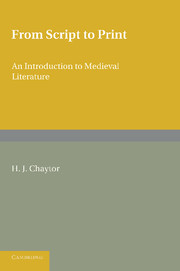Book contents
Chapter II - Reading and Writing
Published online by Cambridge University Press: 05 June 2016
Summary
IN the medieval world, those who could read or write were the few, and it is likely that most of them did not read or write with our methods or with our facility. In order to gain some idea of the difficulties under which they laboured, it is necessary to consider what mental processes are involved in the understanding of spoken or written speech. Psychologists are by no means agreed upon this subject, but most of them would probably accept the following account of its implications.
When we hear the phrase, ‘give me that book’, the word ‘book’ is recognised as a familiar collocation of sounds; in psychological language, we gain an ‘acoustic image’ which experience enables us to identify. This experience includes not only the recognition of particular sounds, but also takes into account pitch, emphasis and intonation; the individual word ‘book’, spoken in isolation, would evoke an image, but would convey no information stimulating to action, unless such information were provided by gesture or emphasis or intonation. In some languages the isolated word has different meanings, according to the ‘tone’ used by the speaker. All languages are, to some extent, ‘tone’ languages; the simple phrase, Good morning', may mean, according to the manner of its utterance, ‘I'm delighted to see you’, or, ‘Here's that infernal bore again’ it may mean, ‘Thank goodness, he's going’, or ‘Come again when you can’.
Experience, therefore, takes into account other matters than the sounds which compose an individual word; but for the purpose of this analysis, we confine our attention to the word as such. The acoustic image may be translated into the visual image of a book, and if the hearer is illiterate, this is probably the end of the process. If the hearer can read, he will substitute for the visual image of a book the printed word ‘book’, and in either case there may be a half-felt tendency to articulate the word, a feeling known to psychology as a ‘kinesthetic’ or ‘speech-motor’ image.
- Type
- Chapter
- Information
- From Script to PrintAn Introduction to Medieval Literature, pp. 5 - 21Publisher: Cambridge University PressPrint publication year: 2013



